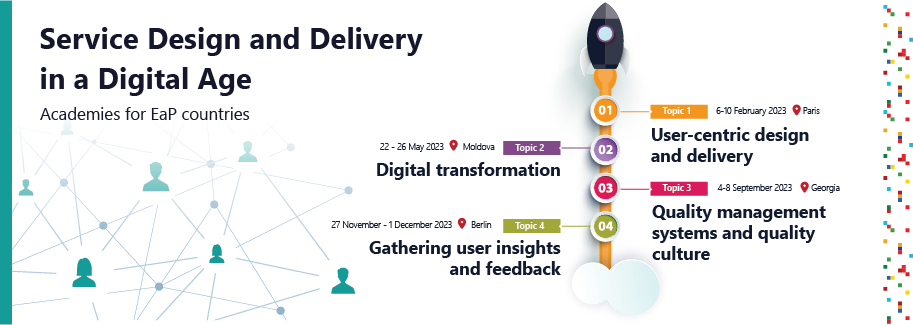SIGMA › Events › Service Design and Delivery in a Digital Age - Academies for EaP countries - OECD
Service Design and Delivery in a Digital Age - Academies for EaP countries - OECD

The SIGMA Programme and the GiZ Eastern Partnership Regional Fund are co-organising a series of academies for EaP countries to promote exchanges on service design and delivery in a digital age. The series will include four events throughout 2023, focusing on dedicated topics. |
 |
IntroductionCitizens and businesses demand better, faster and cheaper public services and they often prefer these to be available online. It is fundamental that public administrations understand user needs and expectations so they can improve processes and provide a user-friendly service catalogue. The development of digital initiatives, such as eGovernment, helps public administrations to commit to service standards and open the door to a new range of opportunities such as measuring user satisfaction and more effective service management. Strategic documents of all EaP countries explicitly state the need for reforms on public service delivery and they give digitalisation a crucial role in improving the performance of public institutions. GiZ, in the framework of the Eastern Partnership Regional Fund for Public Administration Reforms and SIGMA are co-organising a series of academies on service design and delivery in a digital age. This series of events aims at strengthening the foundations for improved public governance and public administration capacities by fostering exchange and synergies: a) At the national level, between key state institutions such as public service development agencies and personal data protection institutions. b) At the regional level, between EaP countries. c) At the international level, between EaP countries and EU Member States. Four academies will be held throughout 2023, focusing on dedicated topics.
|
|
|
|
Public administrations should involve users and not only rely on their own expertise and insights when it comes to service design. While traditional relationships with citizens and users were bureaucratic and hierarchical, new relationships, which are spreading more and more, are instead plural and user-centric. This demands a different approach from public administrations, getting citizens and businesses involved with the objective of gaining insights from their perceptions, expectations and commitment through active participation. |
|
|
Key areas of discussion
|
 |
|
|
|
|
Digitalisation of public administration is not a goal in itself, but a means to improve efficiency, reduce bureaucracy, and help administrations to become more user-friendly and accessible. By undertaking this transformation, public administrations become more open, break administrative silos, and make information available to stakeholders. Another key advantage of this change is interoperability: thanks to digitalisation, institutions can work together, and systems to talk to each other. Many Member States are moving towards ‘once only’ registration of personal data by citizens and businesses, where desired and permitted by law, and online channels are often the default option for accessing public services (‘digital by default’). In this context, it is important that no citizens are left behind by technological change, services should be inclusive and accessible. |
|
|
Key areas of discussion
|
 |
|
|
|
Long-established as a concept in various fields from biology to anthropology, systems thinking is gaining greater prominence in improving the performance and quality of public administration, including within the context of transactional service delivery. The essence of systems thinking is to consider all the relationships within the system and with the external environment to better understand its functioning. The information obtained from this exercise can then be used to improve the system. There is a wide variety of techniques from which organisations can choose to assess and improve the quality of their service delivery. Using these techniques, organisations can be assessed on different characteristics (e.g. leadership style, partnerships, strategy and planning), and generate action plans to improve the aspects where they did not score well, thereby resulting in better service delivery. |
|
Key areas of discussion
|
 |
|
|
|
Ultimately, the test of good service delivery is whether it has lived up to the needs and expectations of the customer. This brings us full circle back to the first step – understanding what users want. Measuring and managing satisfaction are key strategic tool in terms of service transformation. Sophisticated approaches to modelling customer satisfaction allow an organisation to identify the ‘drivers’ of satisfaction or dissatisfaction – the factors that determine whether the user is happy or not. While individual services can be assessed at specific points of their life cycle, a more dynamic analytical approach is required to evaluate user experiences of ‘life events’ (common, crucial moments or stages in the lives of citizens or businesses). |
|
Key areas of discussion
|
 |
Related Documents
.jpg)



